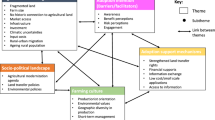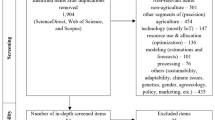Abstract
The adoption of Precision Farming (PF) in Germany has been studied by several mail surveys, telephone interviews and personal interviews with farmers, advisors, teachers and representatives of the PF industry. The intention was to monitor how PF techniques have entered the German market over the years and geographic location. The farmers were interviewed about their experiences with PF technology and their attitudes and barriers towards it. Those farmers who had not yet used PF technologies were asked for the reason and on which condition they would probably start with PF. Although the number of PF users slightly increased between 2001 and 2006, the results of all the surveys indicate that there are still various barriers regarding PF. Those farmers who had already used some PF technologies struggled with many problems at the beginning, but after overcoming these problems, they were generally content with the introduction of PF technologies. However, the majority of the interviewed farmers hesitated to introduce PF techniques mainly because of the high costs of the technology. Most of the interviewed teachers at vocational and technical schools stated that PF was not yet a subject in courses. The interviews with the advisors show that most of them do not offer any advisory service in the field of PF. Finally, the results of the interviews with representatives of the agricultural engineering industry confirm the statements of the other surveys.






Similar content being viewed by others
References
Arnholt, M., Batte, T. M., & Prochaska, S. (2001). Adoption and precision farming technologies: A survey of Central Ohio Precision Farmers. AEDE-RP-0011-01, Agricultural, Environmental and Development Economics. Columbus: Ohio State University, 15 pp.
Atteslander, P. (2006). Methoden der empirschen Sozialforschung [Methods of empirical social research] (pp. 121–139). Berlin, Germany: Walter de Gruyter GmbH & CoKg.
Blackmore, S., Godwin, R., & Fountas, S. (2003). The analysis of spatial and temporal trends in yield map data over six years. Biosystems Engineeering, 84(4), 455–466. doi:10.1016/S1537-5110(03)00038-2.
Blackmore, S., Griepentrog, H. W., Pedersen, S. M., & Fountas, S. (2006). Europe (The current status of precision farming in Europe). In A. Srinivasan (Ed.), Handbook of precision agriculture—principles and applications (pp. 567–607). USA: The Haworth Press.
Batte, T. M., & Arnholt, W. M. (2003). Precision farming adoption and use in Ohio: Case studies of six leading-edge adopters. Computers and Electronics in Agriculture, 38, 125–139. doi:10.1016/S0168-1699(02)00143-6.
Daberkow, S. G., & Mc Bride, W. D. (2000). Adoption of precision agriculture technologies by U.S. farmers. In P. C. Robert, R. H. Rust, & W. E. Larson (Eds.), Proceedings of the 5th International Conference on Precision Agriculture. Madison, WI: ASA/CSSA/SSSA. CDROM.
Daberkow, S. G., & Mc Bride, W. D. (2003). Farm and operator characteristics affecting the awareness and adoption of precision agriculture technologies in the US. Precision Agriculture, 4, 163–177. doi:10.1023/A:1024557205871.
Fink, K. (2006). How to conduct surveys a step-by-step guide (pp. 31–43). Thousands Oaks, CA: SAGE Publications.
Fountas, S., Blackmore, S., Ess, D., Hawkins, S., Blumhoff, G., Lowenberg-Deboer, J., et al. (2005a). Farmer experience with precision agriculture in Denmark and the US Eastern Corn Belt. Precision Agriculture, 6(2), 121–141. doi:10.1007/s11119-004-1030-z.
Fountas, S., Pedersen, S. M., & Blackmore, S. (2005b). ICT in precision agriculture—diffusion of technology. In E. Gelb & A. Offer (Eds.), Ebook: ICT in agriculture. Perspectives of technological innovation. http://departments.agri.huji.ac.il/economics/gelb-main.html Accessed April 30, 2008.
German Federal StatisticalOffice. (2006). Landwirtschaft in Deutschland und in der Europäischen Union 2006 [Agriculture in Germany and in the EU 2006]. Wiesbaden, Germany.
Gelb, E. (2006). Priorities for agricultural research, development and ICT adoption remain a challenge. In V. C. Patil & S. Ninomiya (Eds.), Proceedings of the 5th Conference of the Asian Federation for Information Technology in Agriculture. Bangalore, India.
Gumpertsberger, E., & Jürgens, C. (2003). Acceptance of precision agriculture in Germany—results of a survey in 2001. In J. Stafford & A. Werner (Eds.), Proceedings of the 4th European Conference on Precision Agriculture (pp. 259–264). The Netherlands: Wageningen Academic Press.
Habermehl, W. (1992). Angewandte Sozialforschung [Applied social research] (pp. 157–188). München, Germany: Oldenbourg Wissenschaftsverlag GmbH.
Mc Bride, W. S., & Daberkow, S. G. (2003). Information and the adoption of precision farming technologies. Journal of Agribusiness, 21(1), 21–38.
Pedersen, S. M., Ferguson, R. B., & Lark, M. (2001). A Comparison of producer adoption of precision agriculture practices in Denmark, the United Kingdom and the United States. SJFI—Working Paper No. 2/2001, Danish Institute of Agricultural and Fisheries Economics, Farm Management and Production Systems Division, Denmark, 40 pp.
Pedersen, S. M. (2003). Precision farming—technology assessment of site-specific input application in cereals. Ph.D. Dissertation, Technical University of Denmark, Lyngby.
Pedersen, S. M., Fountas, S., Blackmore, B. S., Gylling, M., & Pedersen, J. L. (2004). Adoption and perspective of precision farming in Denmark. Acta Agriculturae Scandinavica, Section B—Soil and Plant Science, 54(1), 2–8.
Reichardt, M., Jürgens, C., Hüter, J., & Klöble, U. (2006). Precision farming education in Germany—obstacles and solutions. In D. Mullha (Ed.), Proceedings of the 8th International Conference on Precision Agriculture and Other Precision Recourses Management, Minneapolis, USA. CDROM in press.
Reichardt, M., & Jürgens, C. (2007). Adoption and perspective of precision farming in Germany: Results of several surveys among the different agricultural target groups. In J. V. Stafford (Ed.), Precision Agriculture 07—Proceedings of the 6th European Conference on Precision Agriculture (pp. 843–850). Wageningen Academic Publisher.
Schnell, R., Hill, P., & Esser, E. (2005). Methoden der empirischen Sozialforschung [Methods of empirical social research] (pp. 319–388). München, Germany: Oldenbourg Wissenschaftsverlag GmbH.
Sørensen, C. G., Fountas, S., Pedersen, H. H., & Blackmore, S. (2002). Information sources and decision making on precision farming. In P. Robert (Ed.), Precision Agriculture 07: Proceedings of the 6th International Conference on Precision Agriculture and other Precision Resources Management, Minneapolis, USA. CDROM.
Swinton, S. M., & Lowenberg-Deboer, J. (1998). Evaluating the profitability of site-specific farming. Journal of Production Agriculture, 11(4), 439–446.
Swinton, S. M., & Lowenberg-Deboer, J. (2001). Global adoption of precision agriculture technologies: Who, when and why. In G. Grenier & S. Blackmore (Eds.), Precision Agriculture 2001: Proceedings of the 3rd European Conference on Precision Agriculture (pp. 557–562). AgroMontpellier, France.
Wagner, P. (2000). Problems and potential economic impact of precision farming. In C. Conese & A. M. Falci (Eds.), Computer Technology in Agricultural Management and Risk Prevention: Proceedings of the 7th International Congress for Computer Technology in Agriculture (pp. 241–249). Florense: Supplemento agli Atti dell’ Accademia dei Georgofili.
Acknowledgements
This investigation was funded by the German Ministry of Education and Research (BMBF) with the grant reference 0339740/2. This project was part of the collaborative research project preagro II.
Author information
Authors and Affiliations
Corresponding author
Rights and permissions
About this article
Cite this article
Reichardt, M., Jürgens, C. Adoption and future perspective of precision farming in Germany: results of several surveys among different agricultural target groups. Precision Agric 10, 73–94 (2009). https://doi.org/10.1007/s11119-008-9101-1
Published:
Issue Date:
DOI: https://doi.org/10.1007/s11119-008-9101-1




